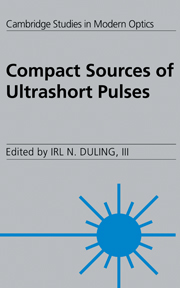Book contents
- Frontmatter
- Contents
- List of contributors
- Acronyms and abbreviations
- Preface
- 1 Short pulse generation
- 2 Passive modelocking in solid state lasers
- 3 Compact modelocked solid state lasers pumped by laser diodes
- 4 Modelocking of all-fiber lasers
- 5 Nonlinear polarization evolution in passively modelocked fiber lasers
- 6 Ultrafast vertical cavity semiconductor lasers
- 7 High power ultrafast semiconductor injection diode lasers
- 8 The hybrid soliton pulse source
- 9 Monolithic colliding pulse modelocked diode lasers
- Index
8 - The hybrid soliton pulse source
Published online by Cambridge University Press: 20 January 2010
- Frontmatter
- Contents
- List of contributors
- Acronyms and abbreviations
- Preface
- 1 Short pulse generation
- 2 Passive modelocking in solid state lasers
- 3 Compact modelocked solid state lasers pumped by laser diodes
- 4 Modelocking of all-fiber lasers
- 5 Nonlinear polarization evolution in passively modelocked fiber lasers
- 6 Ultrafast vertical cavity semiconductor lasers
- 7 High power ultrafast semiconductor injection diode lasers
- 8 The hybrid soliton pulse source
- 9 Monolithic colliding pulse modelocked diode lasers
- Index
Summary
Introduction
The hybrid soliton pulse source (HSPS) described in this chapter is being developed at AT&T Bell Laboratories as a possible source for ultra-long distance soliton communication systems. The HSPS integrates a semiconductor laser gain section and a fiber Bragg reflector in a hybrid device, to capitalize on the inherent advantages each possesses. The semiconductor section allows simple and efficient pumping of the device, and the fiber Bragg reflector provides excellent wavelength and optical bandwidth control. Together these components provide a source which is both simple and inexpensive, whilst satisfying the exacting performance requirements for ultra-long distance soliton transmission systems. Practical soliton transmission systems take advantage of the gain from erbium doped fiber amplifiers to provide lossless transmission, coupled with the nonlinearity in optical fibers to balance dispersion and provide dispersionless transmission (see Mollenauer et al., 1986; 1992; 1993; Gordon and Haus, 1986; Gordon and Mollenauer, 1991; Kodama and Hasegawa, 1987; 1992; Haus, 1991; Mecozzi et al., 1991). Current records for soliton transmission, which offer the largest product of bit-rate multiplied by the error free transmission distance, are 20 GBit/s over 13000 km and 10 GBit/s over 20000 km, by Mollenauer et al. (1993). In order for soliton transmission systems to become a reality, a practical source must be produced which can meet the stringent performance characteristics these systems require. The HSPS described in this chapter is a simple and elegant device which meets these requirements.
- Type
- Chapter
- Information
- Compact Sources of Ultrashort Pulses , pp. 329 - 382Publisher: Cambridge University PressPrint publication year: 1995



